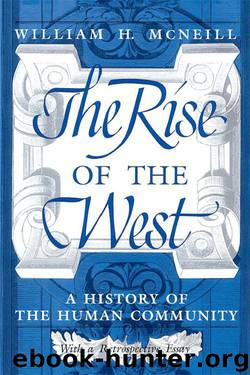Rise of the West: A History of the Human Community by William H. McNeill

Author:William H. McNeill [McNeill, William H.]
Language: eng
Format: epub
Tags: Non-Fiction, 20th Century, v.5, Amazon.com, World History, Retail, History
ISBN: 9780226561448
Amazon: 0226561410
Barnesnoble: 0226561410
Goodreads: 1932185
Publisher: University Of Chicago Press
Published: 1962-12-31T15:00:00+00:00
* * *
Meanwhile, two major centers of high culture had developed in the Americas—one in the highlands of Central America, the other in the coastal valleys and uplands of Peru. These cultures were, of course, the fruit of long centuries of development. Maize, the staple food of both regions, may have been cultivated in Mexico as early as 2500 B.C.; and village life probably established itself there about 1500 B.C. Corresponding developments in Peru seem to have lagged somewhat behind: indeed, maize cultivation and other key techniques may have reached Peru from the north only about 700 B.C.93 If so, the Peruvians, like the ancient Egyptians, compensated for their late start by a more rapid rate of development.94 In any case, the “classic” Mayan civilization seems to have emerged in the highlands of Guatemala almost simultaneously with the formulation of comparable “classic” cultures in central Mexico and Peru.95
All three civilizations had a good deal in common. As in ancient Sumer, priests appear to have been the principal leaders of society; for in all three areas, temples, pyramids, sacred roadways, and other appurtenances of the cult constitute by far the most conspicuous remains. Yet each society had a style of its own, both artistically, where the differences are easily verifiable, and presumably in the general sense as well.
Mayan civilization focused upon a dozen or more ceremonial centers which arose in the jungle areas of Guatemala and adjacent parts of Mexico. Some exchange of expertise among the priests of the different communities must have occurred to keep art styles and intellectual development—above all, the refinement of a very elaborate and amazingly accurate calendar—in harmony. Peasant communities were clustered around the great temple centers, subsisting upon a primitive shifting agriculture which, however, required relatively little labor to produce needed quantities of food.96 By means unknown to us, the priests organized the farmers’ spare time for labor on vast construction works and apparently also maintained a number of professional sculptors and metalworkers to produce the finer works of art. In addition, the Mayan priests developed a system of writing and arithmetical notation, which they used in connection with their elaborate astronomical and calendrical calculation.
Around the core area of Mayan civilization lay a penumbra of other societies which shared most of the Mayans’ techniques. But apparently only in the plateau of central Mexico, near the present Mexico City, did a temple center comparable to those of the Mayan area develop before 600 A.D. The art and architecture of the plateau differed stylistically from the Mayan; but the social systems of the two areas were probably similar.
In Peru, geography dictated a more variegated development. Short river valleys, plunging down from the high Andes to the Pacific, offered a series of coastal sites where the earliest Peruvian high cultures flourished. These valleys were separated from one another by utter desert, and upstream abutted upon a broken topography where mountain valleys and high plateaus offered a second locus capable of sustaining civilized societies. Geography also prompted a really
Download
This site does not store any files on its server. We only index and link to content provided by other sites. Please contact the content providers to delete copyright contents if any and email us, we'll remove relevant links or contents immediately.
| Anthropology | Archaeology |
| Philosophy | Politics & Government |
| Social Sciences | Sociology |
| Women's Studies |
Cecilia; Or, Memoirs of an Heiress — Volume 1 by Fanny Burney(32385)
Cecilia; Or, Memoirs of an Heiress — Volume 3 by Fanny Burney(31760)
Cecilia; Or, Memoirs of an Heiress — Volume 2 by Fanny Burney(31729)
The Great Music City by Andrea Baker(31211)
We're Going to Need More Wine by Gabrielle Union(18914)
All the Missing Girls by Megan Miranda(15423)
Pimp by Iceberg Slim(14237)
Bombshells: Glamour Girls of a Lifetime by Sullivan Steve(13933)
Talking to Strangers by Malcolm Gladwell(13144)
Norse Mythology by Gaiman Neil(13143)
Fifty Shades Freed by E L James(13129)
For the Love of Europe by Rick Steves(12397)
Crazy Rich Asians by Kevin Kwan(9136)
Mindhunter: Inside the FBI's Elite Serial Crime Unit by John E. Douglas & Mark Olshaker(9115)
The Lost Art of Listening by Michael P. Nichols(7366)
Enlightenment Now: The Case for Reason, Science, Humanism, and Progress by Steven Pinker(7094)
The Four Agreements by Don Miguel Ruiz(6552)
Bad Blood by John Carreyrou(6483)
Weapons of Math Destruction by Cathy O'Neil(6090)
